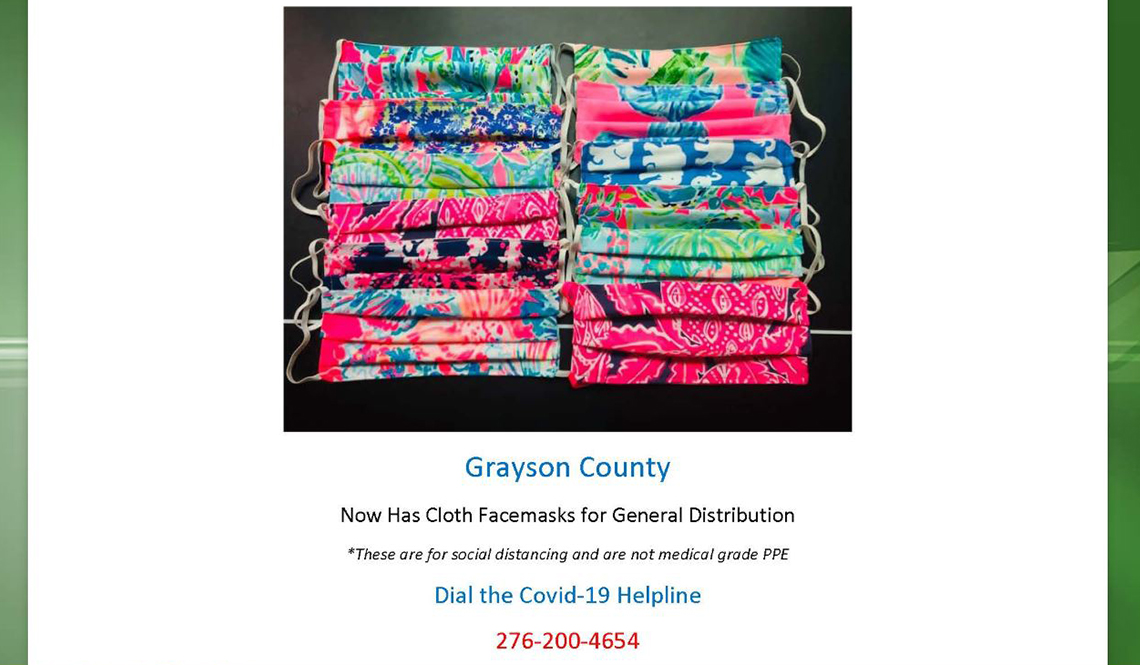Age-Friendly Grayson County, Virginia, Responds to COVID-19
How the county is serving and protecting its older residents
The largely rural community of Grayson County, Virginia, is relatively small. The county is home to only 15,000 residents. But nearly 25 percent of the population is age 65 or older. A member of the AARP Network of Age-Friendly States and Communities since 2017, the area's initiative is called Age-Friendly Grayson County.
Community Representatives:
- William Shepley, Administrator, Grayson County
- Paul D. Hoyle, Emergency Services Coordinator, Grayson County
Shepley and Hoyle explain how the community is helping its older residents during the coronavirus pandemic.
(Information provided to AARP on May 7, 2020)
The Challenge
“Our biggest challenge was how to disseminate information to residents in a county where less than half of the residents are connected to the internet. We wanted to make sure people had information about the current COVID-19 situation, including about suggested protective measures and where to access necessities, such as food and medical assistance.”
The Response
“Recognizing that many people wouldn't be able to access physical needs, such as food or medications, and that we have many state financial assistance programs with long wait periods, we worked to create a more responsive and tailored approach for our citizens. We created a county-supported helpline that anyone can call with their questions about COVID-19 and available resources.
The Focus Areas
“For example, residents have called to ask about transportation for medical treatments or food deliveries. Many came to us saying they wanted to help their fellow citizens but didn't know how to help, so we created a nonprofit to collect donations. The donations support an Emergency Relief Fund that's available to help residents who aren't eligible for other types of assistance or who have an urgent need that wouldn't be met in time through traditional assistance.
"As a small rural county with few employee resources, we tapped residents to staff the helpline. The volunteers are given a resource list and are trained how to log the calls. If a request is more complicated, they can pass the request along to our office. Their work has helped us strengthen the processes and conduits for sharing information.
"The local newspapers have been helpful in getting the word out about safety measures and updates about COVID-19. For people who do have reasonable internet access, the county website has a Coronavirus Info page with important safety guidelines and links to state and national resources.
"A tremendous number of volunteers have also stepped forward to make masks, deliver groceries and simply support people however is needed. A group of residents stepped forward early on and made 150 masks. Since volunteering could increase the risk for these individuals, we provided training and resources about how to protect themselves and the people they're assisting."
Response Partners
The Results, Thus Far
"Helping one another is really what this county is all about. While this was clear before, it has become so much stronger during the COVID-19 crisis, especially among our older residents, many of whom live alone in fairly remote areas.
"Prior to COVID, these residents had created a system for checking on one another that has become especially valuable today. The attitude is that there may be obstacles in the way, but we'll figure out a solution.
"In the five weeks we've been operating the helpline we've had 44 calls, roughly one per day. While this may not seem like a lot, for a county our size that's a good number. Many of the callers are reaching out on behalf of local groups, such as faith-based organizations, which then share the resources widely.
"While Grayson County staff put the strategies in place, our grassroots volunteers — those staffing the helpline, delivering groceries, donating money, working as emergency medical services providers or firefighters — have fueled our success."
Research by Shosanna Preuss | Article published May 2020
- Learn about the AARP Network of Age-Friendly States and Communities
- Check out the network's Member List
- Connect with AARP Virginia
- Find more Age-Friendly Responses to COVID-19
Stay Informed
The weekly, award-winning AARP Livable Communities e-Newsletter provides local leaders with information and inspiration for making their town, city or neighborhood more livable for older adults and people of all ages. Subscribe today!
AARP.org/Livable
Enter a topic, name, place, etc.




